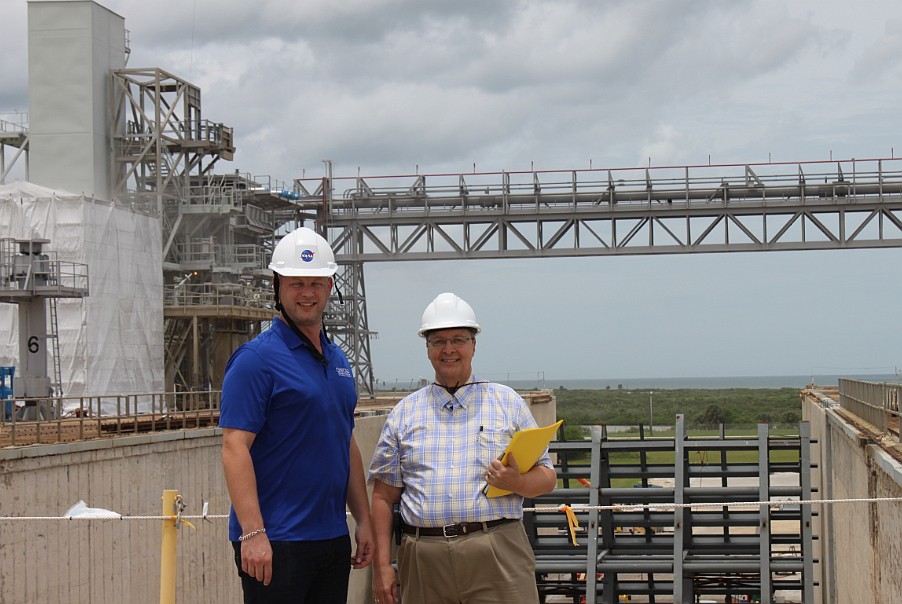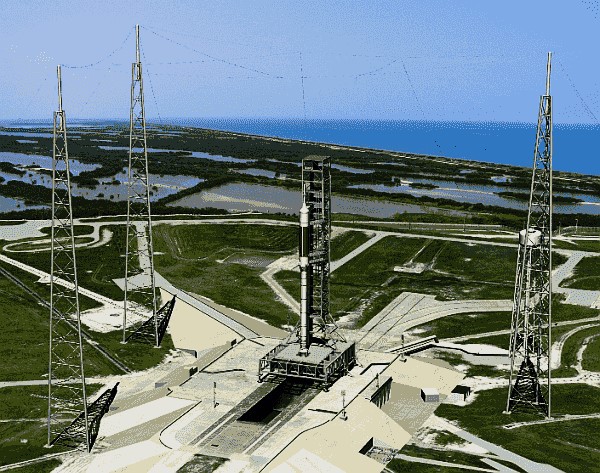In 2017 I visited NASA Kennedy Space Center, not the tourist center (Which is a very educational site as well), but a visit behind the scenes where not many non-NASA people venture.
One of the areas I asked to be taken was Launch Pad 39B. This was one of two Space Shuttle launch pads---the other was right nearby, at Launch Pad 39A, which is being leased by Space X.
I toured that Launch Complex 39B site which was being totally renovated for the Mars Orion program. The most powerful rocket in the world, NASA’s Apace Launch System (SLS) Block 2, will sit atop this trench behind us in Figure 1. The flame and exhaust from the four RS-25 engines will provide 11.9 million lbs. of thrust!

Figure 1 Nick Moss (left), Pad Deputy Project Manager, and me (right) are at Launch Pad 39B in front of the Flame Trench which is 490 feet long, 58 feet wide, and 42 feet deep. This launch pad was under major renovation for the Mars Orion program whose SLS rocket will launch astronauts to the Moon and Mars. (Image courtesy of Loretta Taranovich)
One area really caught my eye, that of the three large Lightning Arrestor towers (Figure 2) which prevent a spacecraft from being struck by Florida’s frequent, and sometimes dangerous, thunderstorms. A strong lightning strike to a spacecraft could wreak havoc on the electronics and end in disaster.

Figure 2 Three of these towers surround Launch Complex 39B connected at the top to each other with stainless steel cables arranged in a pattern (See Figure 3). The construction of the foundation of these towers includes 216 concrete pilings under the ground as far as 55 feet—that’s a solid ground that a lightning bolt will be happy to enter. (Image courtesy of Loretta Taranovich)
There are three tall steel masts with down conductors which will divert the surging electrical current from a powerful lightning strike safely away from the rocket and into the very excellent ground. The three towers are all connected at the top to each other with stainless steel cables arranged in a pattern. See Figure 3. The large stainless steel cables are strung between three, 594-foot tall, towers constructed of steel and fiberglass. This is known as a catenary wire system. The construction at the foundation of these towers embeds 216 concrete pilings under the ground extending as far down as 55 feet. Alltec Global Systems explains this lightning arrester technique best here.

Figure 3 The spacecraft, atop the Launch System rocket, will fly through an opening in between the stainless-steel cables tightly strung above and connected to three masts. (Image courtesy of Loretta Taranovich)
The towers are not simply to divert a lightning strike, but are also equipped with weather monitoring systems which can help predict weather and the likelihood of lightning occurrences. Each tower has four arms containing weather instruments at different height levels on these masts. At each level wind velocity and direction, relative humidity, and temperature is measured and that data is sent to operators monitoring and analyzing that information before launch. You would be surprised how different weather conditions can be at each different level on the mast; those four arms, at each increasing height level on the tower, give a more complete picture of how the weather patterns are behaving at any instant in time.
Also, in the event of a severe tropical storm and the area may have been evacuated, computers in the Pad Terminal Connection Room (PTCR), in a basement area below the Launch Pad surface, will store all of the data for future analysis. Weather prediction is a critical element in modern launches.
Finally, the perimeter of the Launch Pad contains nine down-conductors and also four B-dot (The time-derivative of an Inductive magnetic field or dB/dt) and five D-dot (The time-derivative of electric flux density or dD/dt) stations that will identify when and where lightning has struck, how strong it was, and how much disruption was caused. These sensors are monitored by high-speed transient video and data recorders down in the PTCR, and operate at high-speed. The integration of the probe outputs will give instantaneous values for electric and magnetic fields due to lightning.
Safe launches have a far increased success rate with this system; especially when they are occupied by astronauts.
Reference
- A new comprehensive lightning instrumentation system for pad 39B at the Kennedy Space Center, Florida, C. Mata, V. Rakov, T. Bonilla, A. Mata, E. Navedo, G. Snyder, 30th International Conference on Lightning Protection – ICLP 2010 (Cagliari, Italy – September 13th -17th, 2010)
 Steve Taranovich
Steve Taranovich
Discussions
Become a Hackaday.io Member
Create an account to leave a comment. Already have an account? Log In.